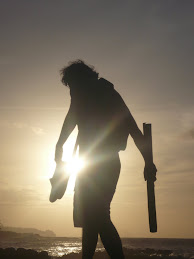Altaitsudz means 'Golden' ('altai') 'Cup' ('tsudz'), and as we descend from the rocky grey hillsides into the basin below, the reason for its name becomes obvious.
Photo: Entering Altaitsudz foodbowl.Around 60km away from, and 300m below Ulgii City's average elevation (1,600m above sea level), it is considerably warmer here during the summer (so much so that mosquitoes can be a problem), providing better growing conditions (provided you can withstand the mosquito hordes), and as such is a veggie food bowl for the province ('agricultural' usually means livestock production in Mongolia).The riverflats are thick with skeletal white trees (Populus laurifolia (Laurel-leafed Poplar), and varieties of Salix (Willow)), and the gently sloping river plains around are carpeted with golden winter grasses, and dotted with hardy red Caragana shrubs(i). Bactrian camels, horse, and cattle browse the autumn-coloured palette nonchalantly, and closer to the soum, irrigation channels criss-cross the landscape around growing plots.Our mission today: to visit the large-scale vegetable growing plot owned by retired Gold-Medalist-Mongol-Kazakh boxing star Beket (who must be somehow related to Dr. Beket, though I was unable to find out how), who is a friend of Guliya (our student from World Vision).The plot is approximately 5,000 square meters, and is nestled against the edge of a basin about 45 minutes' drive from Altaitsudz soum (which, in turn, is about an hour-and-a-half from Ulgii City) - seemingly in the middle of nowhere (I might have mentioned that distance is relative to Monoglians).
Photos: The plot.
The tightly wound slate-post-and-wire fence (slate posts! ...I winced as I remembered how expensive the slate floors in my old bathroom was... this slate was likely harvested from the surrounding hills, where it flakes off in large slabs) surrounding the plot announces the abundance of the owner's resources, which we confirm when we are shown to two artesian wells (dug 18 meters down to reach the water table), a greenhouse built upon concrete foundations, and later, a dam built 5 km away to divert a small river 2.5 km closer to the plot (made from old car frames, rubble, and sandbags).
Photos: Very expensive water harvesting.
250 seabuckthorn trees have been planted along the northwestern section, the innermost of which bore their first fruit last season. A small experimental plot of oats and alfalpha sit next to the seabuckthorn plantation, with carrot and melon plots above that.
Photos: Seabuckthorn orchard.
'What', he asks, 'does the guy from Australia suggest we do to improve?'
Photo: Me and the (very) Big Guy
It takes a few moments to thaw my brain enough to formulate an answer, and I rub my nose with my frozen fingers to see if it is still on my face (it went numb shortly after arriving). Well, I chatter, we might start by getting some of this wind off your crops. It might help.
If distance is relative in Mongolia, than 'wind-chill-factor' is something locals notice only when a gale-force blizzard kicks up: 'Bit windy out today, tzaaaa...!?'We noticed this last year in The Gobi, when we -asked- howled through the wind 'DO YOU FIND THE WIND TO BE A PROBLEM?', to be met with indifferent shrugs through the stinging sandblast we were copping. Like fish who do not realize they are in the water (until taken out of it), it so often is with locals in their enviornment (wherever in the world you may be); because they live in these conditions every day, the obvious can go overlooked.And this, perhaps, is where an outsider's perspective can add value.But only if his brain thaws out in time. Photo: (L to R: Bek, Beket, Dr Beket, Doc, and Matt.)_________________________(i) a hardy, nitrogen-fixing pioneer species occurring throughout the region in various incarnations, from ground cover to large hedging tree-shrub.


No comments:
Post a Comment